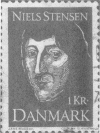Abstract
Changes in the size of the test components (R1 and R2) of the trigemino-facial reflex were studied after electrical subliminal conditioning stimulation were applied to the trigeminal, median and sural nerves. After conditioning activation of the trigeminal nerve (below the reflex threshold), the early R1 reflex component showed phasic facilitation, peaking at about 50 ms of interstimulus delay, followed by a long-lasting inhibition recovering at 300-400 ms. The same conditioning stimulation resulted in a monotonic inhibition of the late R2, starting at 15-20 ms, with a maximum at 100-150 ms and lasting 300-400 ms. Intensity threshold for both the R1 and R2 changes ranged from 0.90 to 0.95 times the perception threshold. A similar longlasting inhibition of the R2 reflex response was also seen after conditioning stimulation applied to low-threshold cutaneous afferents of the median and sural nerves. The minimum effective conditioning-test interval was 25-30 ms and 40-45 ms respectively and lasted 600-700 ms. By contrast the early R1 reflex response exhibited a slight long-lasting facilitation with a time course similar to that of the R2 inhibition. The threshold intensity to obtain facilitation of the R1 and inhibition of the R2 test responses after conditioning volley in the median and sural nerves was similar and ranged from 0.9 to 1.2 times the perception threshold. These results demonstrate that low-threshold cutaneous afferents from trigeminal and limb nerves exert powerful control on trigeminal reflex pathways, probably via a common neural substrate. There is evidence that, in addition to any post-synaptic mechanism which might be operating, presynaptic control is a primary factor contributing to these changes.
Full text
PDF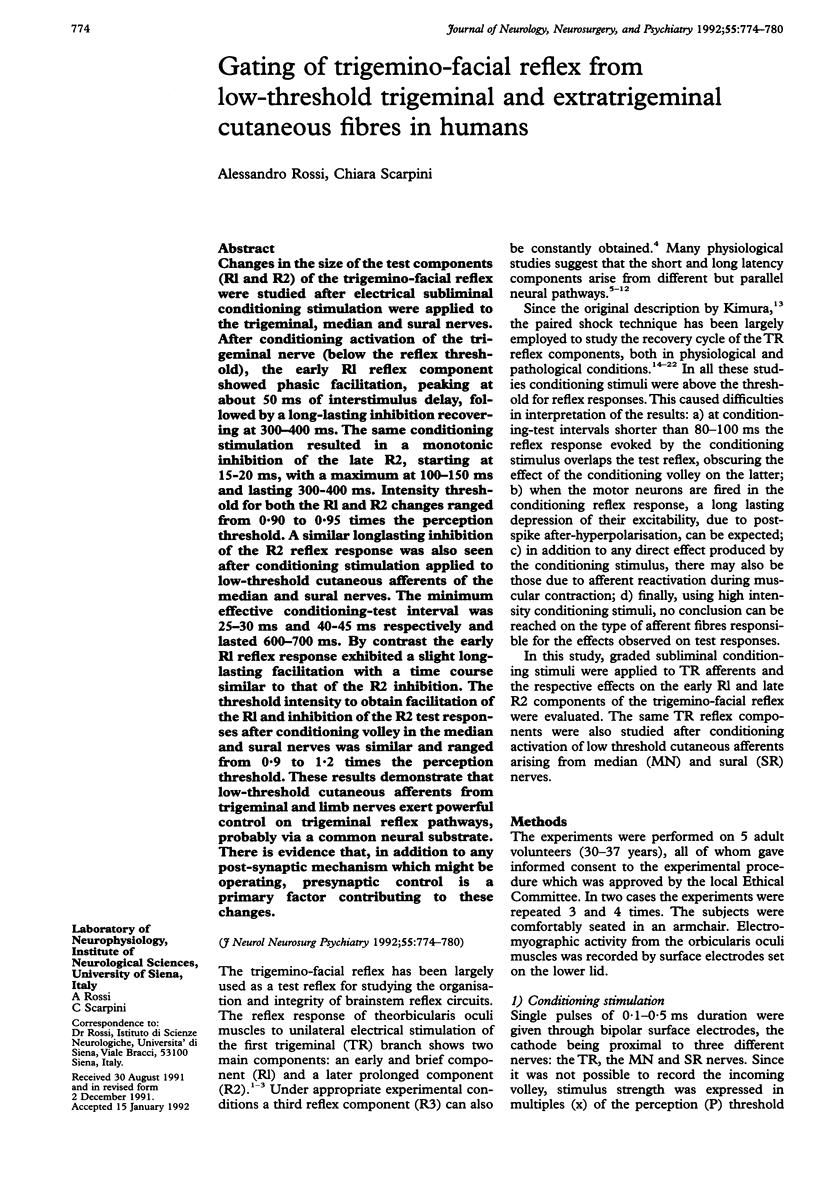
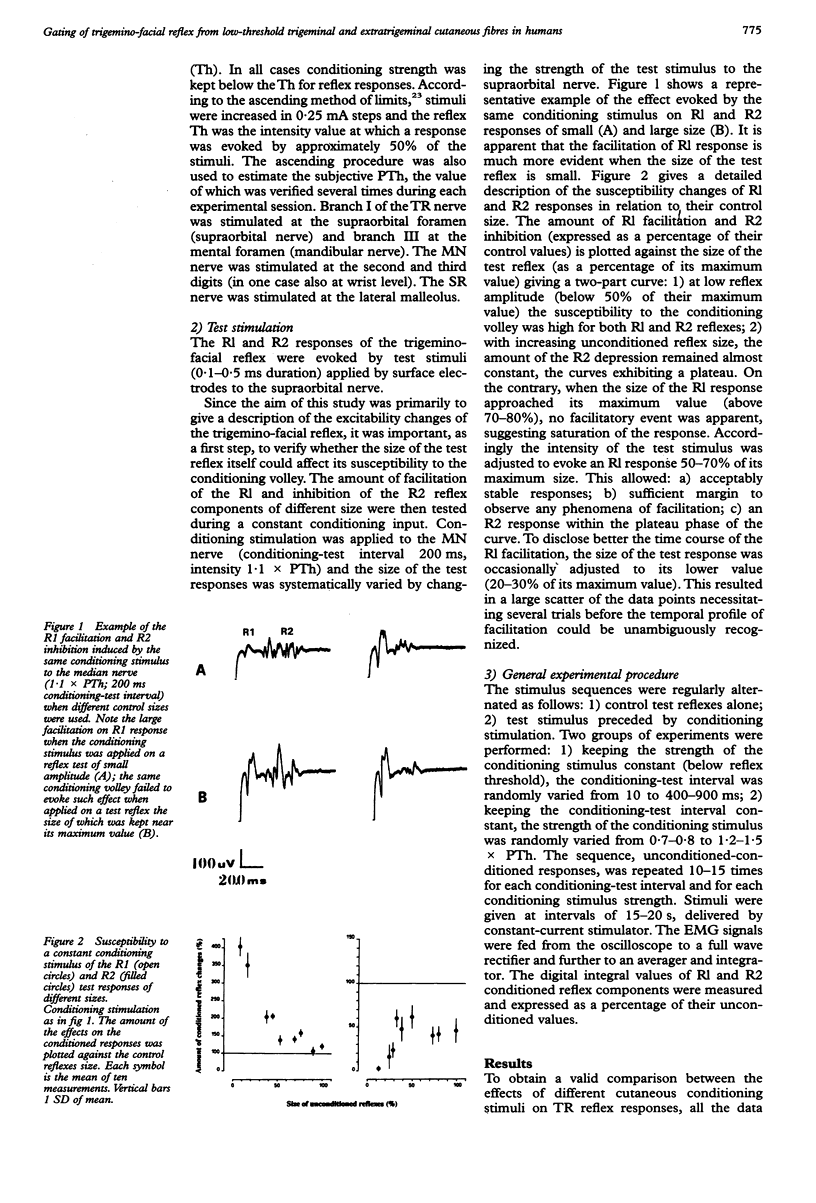
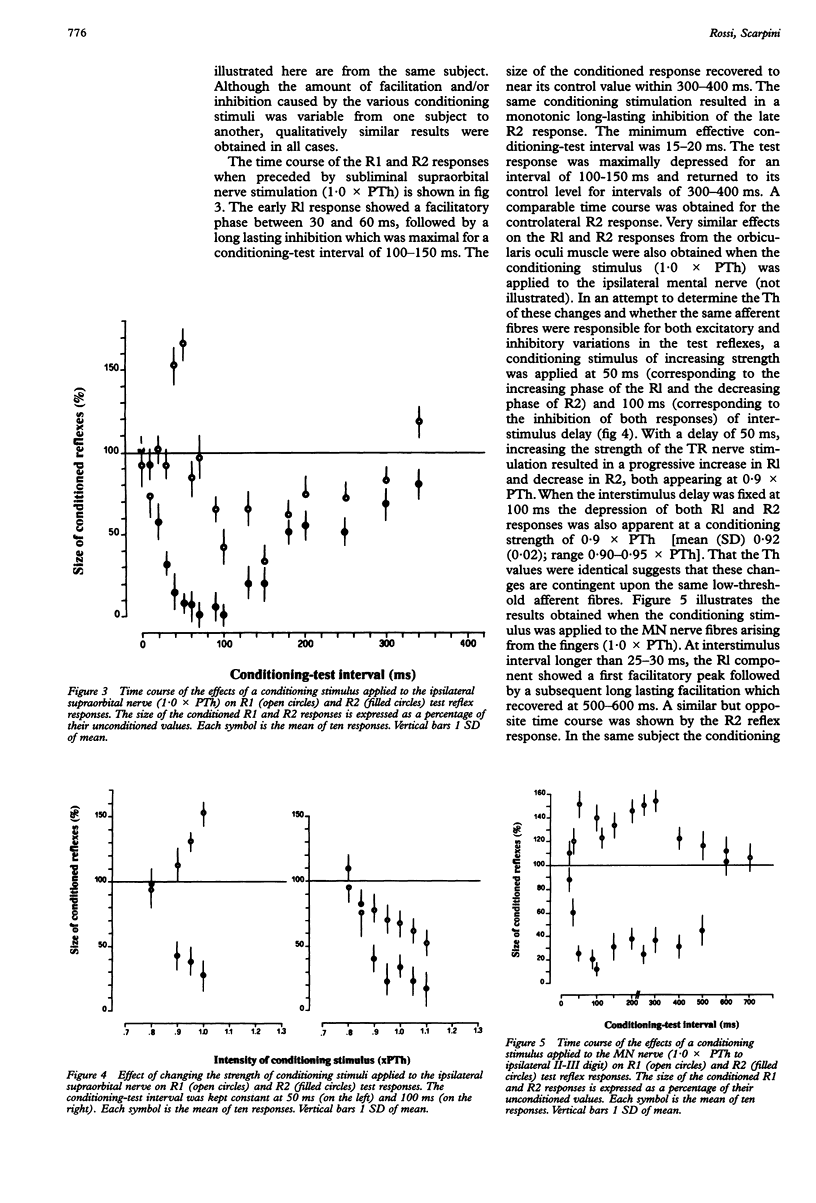
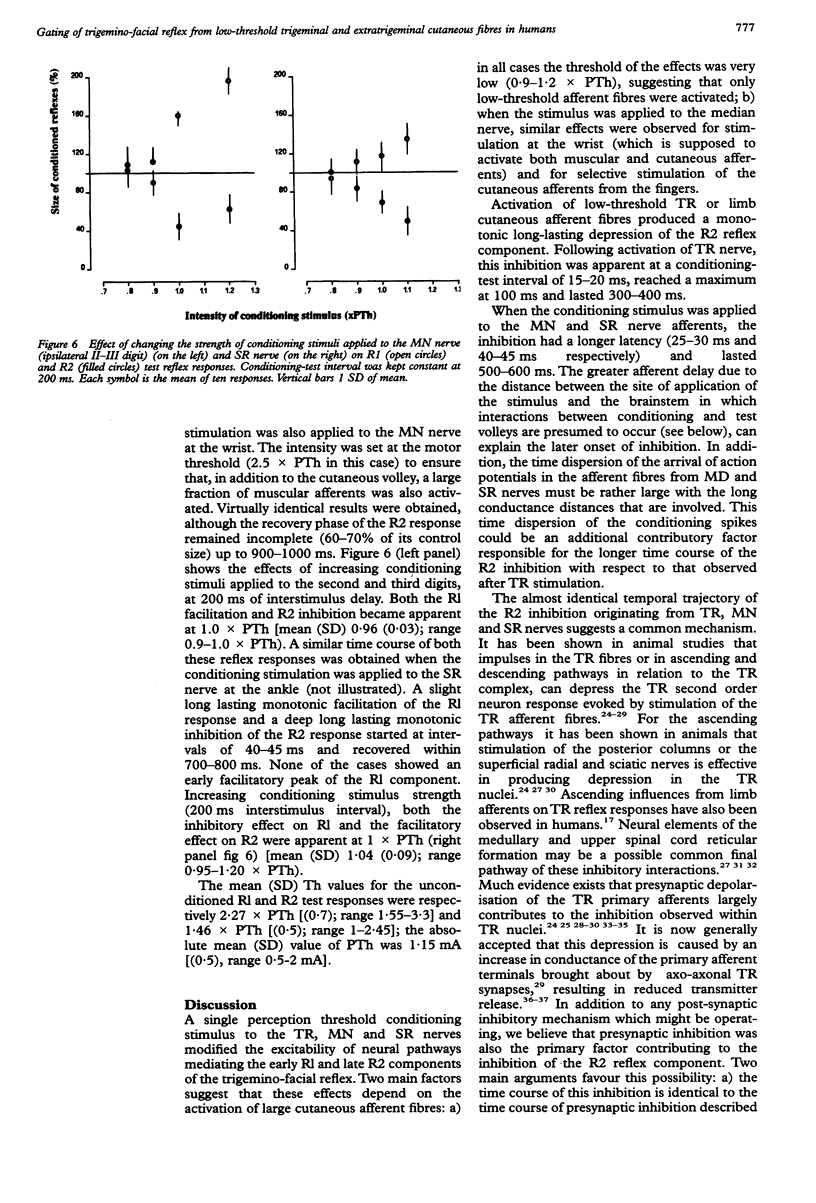
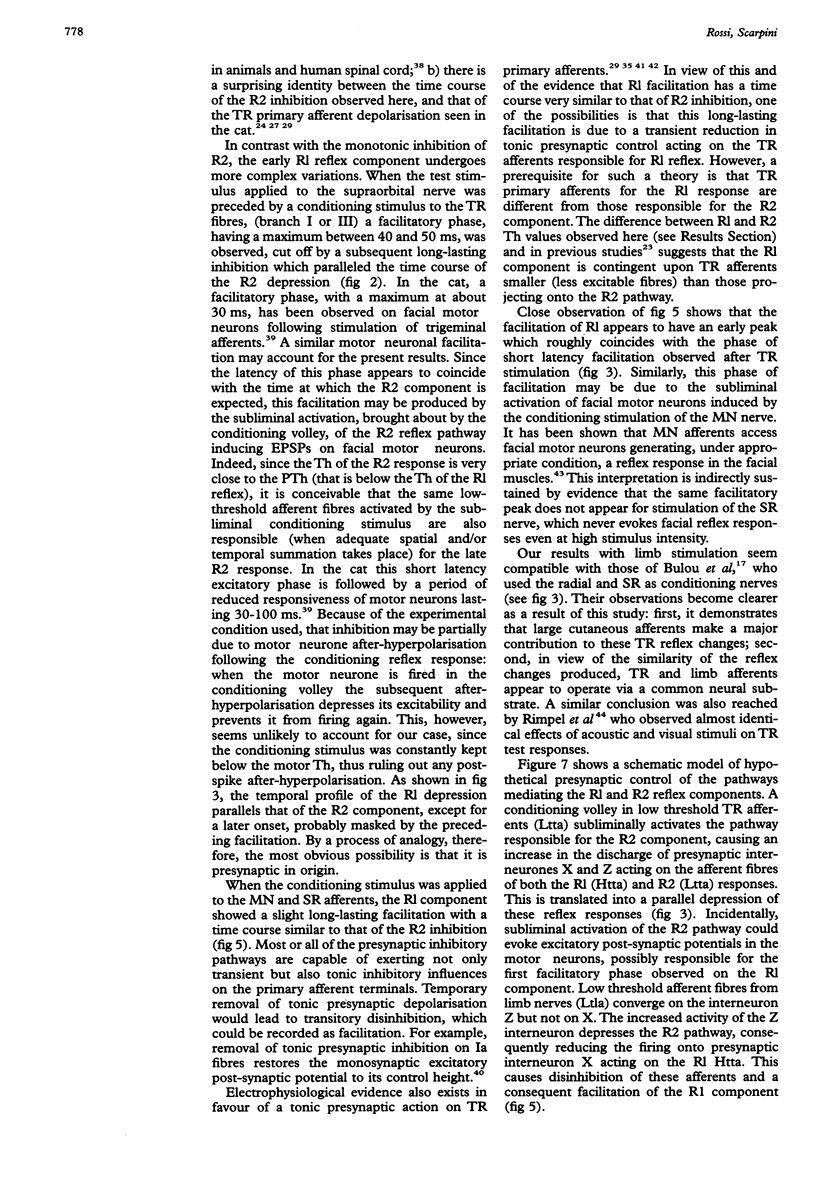

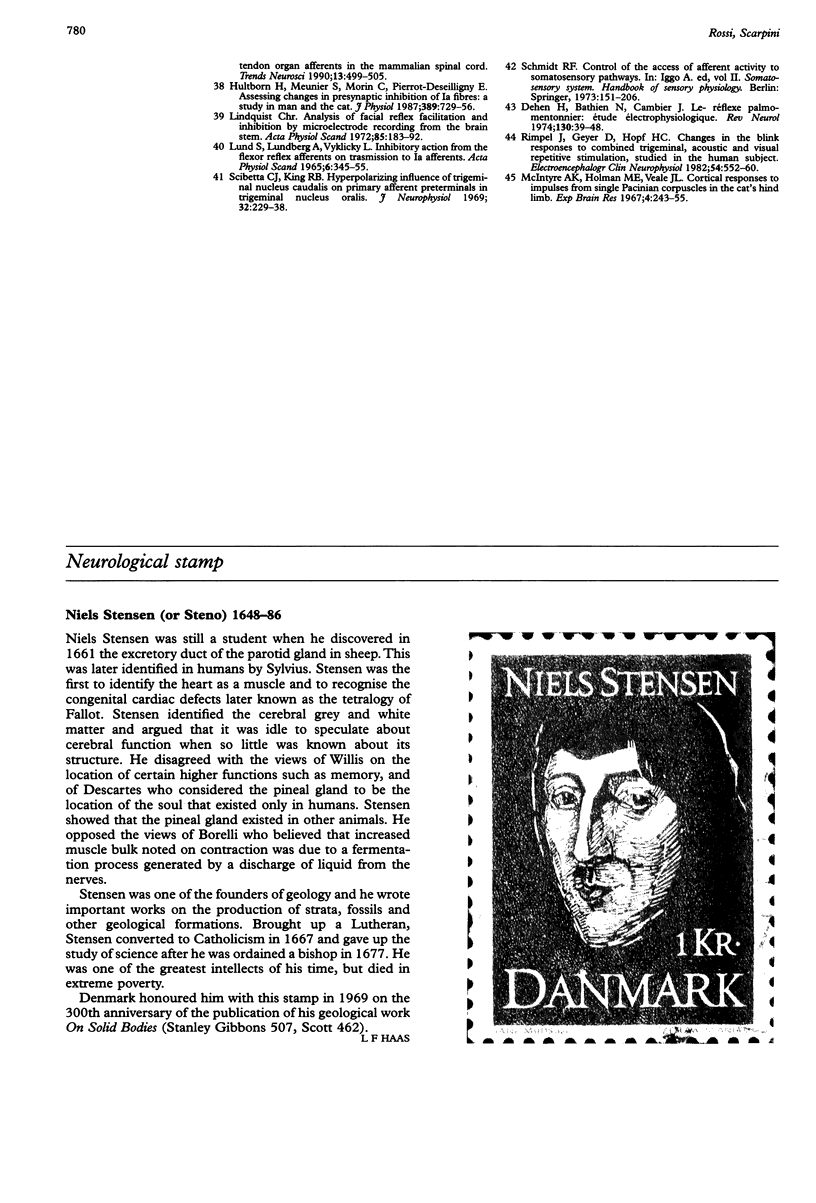
Images in this article
Selected References
These references are in PubMed. This may not be the complete list of references from this article.
- Baldissera F., Broggi G., Mancia M. Depolarization of trigeminal afferents induced by stimulation of brain-stem and peripheral nerves. Exp Brain Res. 1967;4(1):1–17. doi: 10.1007/BF00235213. [DOI] [PubMed] [Google Scholar]
- Berardelli A., Rothwell J. C., Day B. L., Marsden C. D. Pathophysiology of blepharospasm and oromandibular dystonia. Brain. 1985 Sep;108(Pt 3):593–608. doi: 10.1093/brain/108.3.593. [DOI] [PubMed] [Google Scholar]
- Boulu P., Willer J. C., Cambier J. Analyse electrophysiologique du réflexe de clignement chez l'homme: interactions des afférences sensitives segmentaires et intersegmentaires, des afférences auditives et visuelles. Rev Neurol (Paris) 1981;137(8-9):523–533. [PubMed] [Google Scholar]
- Caraceni T., Avanzini G., Spreafico R., Negri S., Broggi G., Girotti F. Study of the excitability cycle of the blink reflex in Huntington's chorea. Eur Neurol. 1976;14(6):465–472. doi: 10.1159/000114774. [DOI] [PubMed] [Google Scholar]
- DARIAN-SMITH I. PRESYNAPTIC COMPONENT IN THE AFFERENT INHIBITION OBSERVED WITHIN TRIGEMINAL BRAIN-STEM NUCLEI OF THE CAT. J Neurophysiol. 1965 Jul;28:695–709. doi: 10.1152/jn.1965.28.4.695. [DOI] [PubMed] [Google Scholar]
- Darian-Smith I., Yokota T. Cortically evoked depolarization of trigeminal cutaneous afferent fibers in the cat. J Neurophysiol. 1966 Mar;29(2):170–184. doi: 10.1152/jn.1966.29.2.170. [DOI] [PubMed] [Google Scholar]
- Dehen H., Bathien N., Cambier J. Le réflexe palmo-mentonnier: étude électrophysiologique. Rev Neurol (Paris) 1974 Jan-Feb;130(1-2):39–48. [PubMed] [Google Scholar]
- Evinger C., Manning K. A. A model system for motor learning: adaptive gain control of the blink reflex. Exp Brain Res. 1988;70(3):527–538. doi: 10.1007/BF00247600. [DOI] [PubMed] [Google Scholar]
- Evinger C., Sibony P. A., Manning K. A., Fiero R. A. A pharmacological distinction between the long and short latency pathways of the human blink reflex revealed with tobacco. Exp Brain Res. 1988;73(3):477–480. doi: 10.1007/BF00406604. [DOI] [PubMed] [Google Scholar]
- Ferguson I. T., Lenman J. A., Johnston B. B. Habituation of the orbicularis oculi reflex in dementia and dyskinetic states. J Neurol Neurosurg Psychiatry. 1978 Sep;41(9):824–828. doi: 10.1136/jnnp.41.9.824. [DOI] [PMC free article] [PubMed] [Google Scholar]
- Fox J. E., Wolstencroft J. H. The reduced responsiveness of neurones in nucleus reticularis gigantocellularis following their excitation by peripheral nerve stimulation. J Physiol. 1976 Jul;258(3):687–704. doi: 10.1113/jphysiol.1976.sp011441. [DOI] [PMC free article] [PubMed] [Google Scholar]
- Hammer B., Tarnecki R., Vyklicky L., Wiesendanger M. Corticofungal control of presynaptic inhibition in the spinal trigeminal complex of the cat. Brain Res. 1966 Feb;1(2):216–218. doi: 10.1016/s0006-8993(66)80084-7. [DOI] [PubMed] [Google Scholar]
- Hatanaka T., Yasuhara A., Kobayashi Y. Electrically and mechanically elicited blink reflexes in infants and children--maturation and recovery curves of blink reflex. Electroencephalogr Clin Neurophysiol. 1990 Jul;76(1):39–46. doi: 10.1016/0013-4694(90)90056-p. [DOI] [PubMed] [Google Scholar]
- Hiraoka M., Shimamura M. Neural mechanisms of the corneal blinking reflex in cats. Brain Res. 1977 Apr 15;125(2):265–275. doi: 10.1016/0006-8993(77)90620-5. [DOI] [PubMed] [Google Scholar]
- Hultborn H., Meunier S., Morin C., Pierrot-Deseilligny E. Assessing changes in presynaptic inhibition of I a fibres: a study in man and the cat. J Physiol. 1987 Aug;389:729–756. doi: 10.1113/jphysiol.1987.sp016680. [DOI] [PMC free article] [PubMed] [Google Scholar]
- Inagaki M., Takeshita K., Nakao S., Shiraishi Y., Oikawa T. An electrophysiologically defined trigemino-reticulo-facial pathway related to the blink reflex in the cat. Neurosci Lett. 1989 Jan 2;96(1):64–69. doi: 10.1016/0304-3940(89)90244-9. [DOI] [PubMed] [Google Scholar]
- KUGELBERG E. [Facial reflexes]. Brain. 1952 Sep;75(3):385–396. doi: 10.1093/brain/75.3.385. [DOI] [PubMed] [Google Scholar]
- Kimura J. Disorder of interneurons in Parkinsonism. The orbicularis oculi reflex to paired stimuli. Brain. 1973;96(1):87–96. doi: 10.1093/brain/96.1.87. [DOI] [PubMed] [Google Scholar]
- Kimura J., Harada O. Recovery curves of the blink reflex during wakefulness and sleep. J Neurol. 1976;213(3):189–198. doi: 10.1007/BF00312869. [DOI] [PubMed] [Google Scholar]
- Lindquist C. Analysis of facial reflex facilitation and inhibition by microelectrode recording from the brain stem. Acta Physiol Scand. 1972 Jun;85(2):183–192. doi: 10.1111/j.1748-1716.1972.tb05249.x. [DOI] [PubMed] [Google Scholar]
- Lindquist C., Mårtensson A. Mechanisms involved in the cat's blink reflex. Acta Physiol Scand. 1970 Oct;80(2):149–159. doi: 10.1111/j.1748-1716.1970.tb04780.x. [DOI] [PubMed] [Google Scholar]
- Lund S., Lundberg A., Vyklický L. Inhibitory action from the flexor reflex afferents on transmission to Ia afferents. Acta Physiol Scand. 1965 Aug;64(4):345–355. doi: 10.1111/j.1748-1716.1965.tb04189.x. [DOI] [PubMed] [Google Scholar]
- McIntyre A. K., Holman M. E., Veale J. L. Cortical responses to impulses from single Pacinian corpuscles in the cat's hind limb. Exp Brain Res. 1967;4(3):243–255. doi: 10.1007/BF00248025. [DOI] [PubMed] [Google Scholar]
- Ongerboer de Visser B. W., Kuypers H. G. Late blink reflex changes in lateral medullary lesions. An electrophysiological and neuro-anatomical study of Wallenberg's Syndrome. Brain. 1978 Jun;101(2):285–294. doi: 10.1093/brain/101.2.285. [DOI] [PubMed] [Google Scholar]
- Ongerboer de Visser B. W., Moffie D. Effects of brain-stem and thalamic lesions on the corneal reflex: an electrophysiological and anatomical study. Brain. 1979 Sep;102(3):595–608. doi: 10.1093/brain/102.3.595. [DOI] [PubMed] [Google Scholar]
- RUSHWORTH G. Observations on blink reflexes. J Neurol Neurosurg Psychiatry. 1962 May;25:93–108. doi: 10.1136/jnnp.25.2.93. [DOI] [PMC free article] [PubMed] [Google Scholar]
- Rimpel J., Geyer D., Hopf H. C. Changes in the blink responses to combined trigeminal, acoustic and visual repetitive stimulation, studied in the human subject. Electroencephalogr Clin Neurophysiol. 1982 Nov;54(5):552–560. doi: 10.1016/0013-4694(82)90040-2. [DOI] [PubMed] [Google Scholar]
- Rossi B., Giannini C., Siciliano G., Sartucci F. The role of the tactile-pressure afferents in the habituation phenomenon of trigemino-facial reflex. Acta Neurol Scand. 1985 Dec;72(6):602–605. doi: 10.1111/j.1600-0404.1985.tb00920.x. [DOI] [PubMed] [Google Scholar]
- Rossi B., Risaliti R., Rossi A. The R3 component of the blink reflex in man: a reflex response induced by activation of high threshold cutaneous afferents. Electroencephalogr Clin Neurophysiol. 1989 Oct;73(4):334–340. doi: 10.1016/0013-4694(89)90111-9. [DOI] [PubMed] [Google Scholar]
- Rowe M. J., Carmody J. J. Afferent inhibition over the response range of secondary trigeminal neurones. Brain Res. 1970 Mar 3;18(2):371–374. doi: 10.1016/0006-8993(70)90338-0. [DOI] [PubMed] [Google Scholar]
- Sanes J. N., Foss J. A., Ison J. R. Conditions that affect the thresholds of the components of the eyeblink reflex in humans. J Neurol Neurosurg Psychiatry. 1982 Jun;45(6):543–549. doi: 10.1136/jnnp.45.6.543. [DOI] [PMC free article] [PubMed] [Google Scholar]
- Scibetta C. J., King R. B. Hyperpolarizing influence of trigeminal nucleus caudalis on primary afferent preterminals in trigeminal nucleus oralis. J Neurophysiol. 1969 Mar;32(2):229–238. doi: 10.1152/jn.1969.32.2.229. [DOI] [PubMed] [Google Scholar]
- Shahani B. T., Young R. R. Human orbicularis oculi reflexes. Neurology. 1972 Feb;22(2):149–154. doi: 10.1212/wnl.22.2.149. [DOI] [PubMed] [Google Scholar]
- Shende M. C., King R. B. Excitability changes of trigeminal primary afferent preterminals in brain-stem nuclear complex of squirrel monkey (Saimiri sciureus). J Neurophysiol. 1967 Sep;30(5):949–963. doi: 10.1152/jn.1967.30.5.949. [DOI] [PubMed] [Google Scholar]
- Stewart D. H., Jr, King R. B. Effect of conditioning stimuli upon evoked potentials in the trigeminal complex. J Neurophysiol. 1966 May;29(3):442–455. doi: 10.1152/jn.1966.29.3.442. [DOI] [PubMed] [Google Scholar]
- Tamai Y., Iwamoto M., Tsujimoto T. Pathway of the blink reflex in the brainstem of the cat: interneurons between the trigeminal nuclei and the facial nucleus. Brain Res. 1986 Aug 13;380(1):19–25. doi: 10.1016/0006-8993(86)91424-1. [DOI] [PubMed] [Google Scholar]
- Trontelj M. A., Trontelj J. V. Reflex arc of the first component of the human blink reflex: a single motoneurone study. J Neurol Neurosurg Psychiatry. 1978 Jun;41(6):538–547. doi: 10.1136/jnnp.41.6.538. [DOI] [PMC free article] [PubMed] [Google Scholar]
- Valls-Sole J., Tolosa E. S. Blink reflex excitability cycle in hemifacial spasm. Neurology. 1989 Aug;39(8):1061–1066. doi: 10.1212/wnl.39.8.1061. [DOI] [PubMed] [Google Scholar]
- Wiesendanger M., Hammer B., Tarnecki R. Corticofugal control of the presynaptic inhibition in the spinal trigeminal nucleus of the cat. The effect of pyramidotomy and barbiturates. Schweiz Arch Neurol Neurochir Psychiatr. 1967;100(2):255–276. [PubMed] [Google Scholar]



